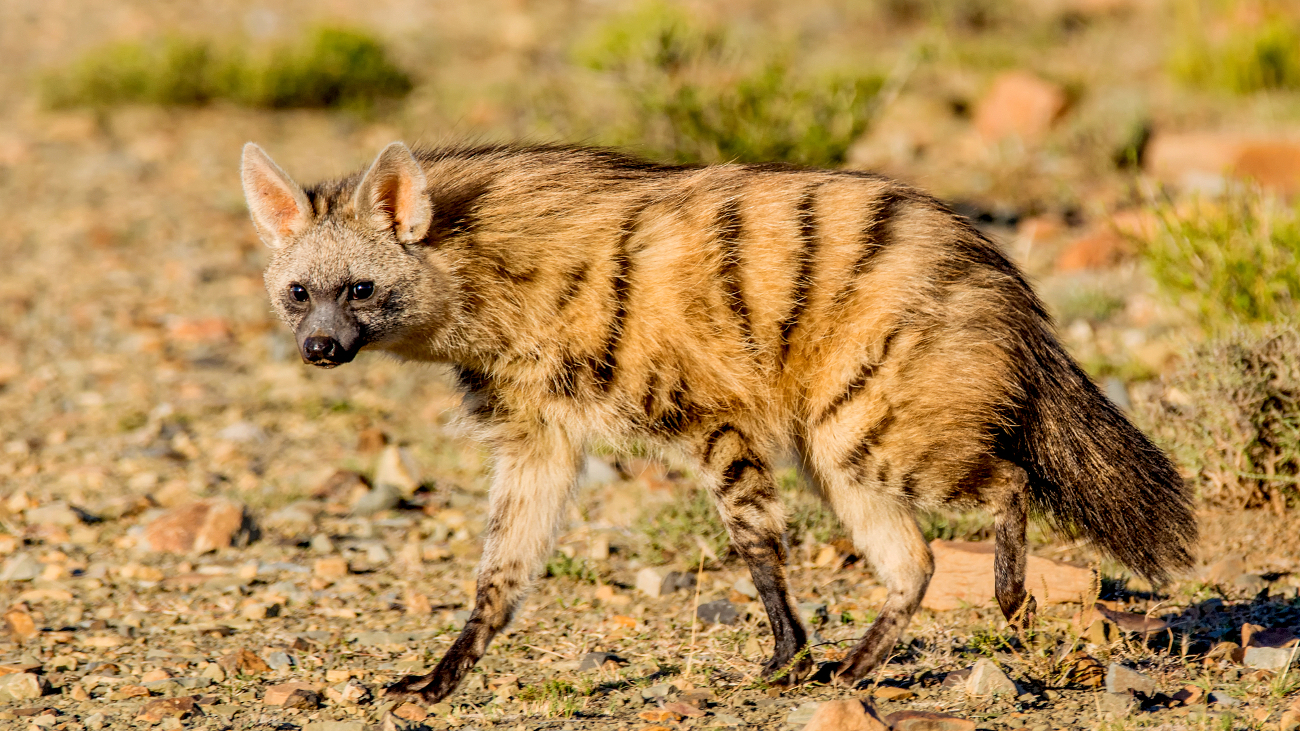- Home
- Conservancy
- Aardwolf
Description
The aardwolf resembles a very thin striped hyena, but with a more slender muzzle, black vertical stripes on a coat of yellowish fur, and a long, distinct mane down the midline of the neck and back. It also has one or two diagonal stripes down the fore and hindquarters, along with several stripes on its legs. The mane is raised during confrontations in order to make the aardwolf appear larger. It is missing the throat spot that others in the family have. Its lower leg (from the knee down) is all black, and its tail is bushy with a black tip. The aardwolf is about 55 to 80 centimetres (22 to 31 in) long, excluding its bushy tail, which is about 20–30 centimetres (7.9–11.8 in) long, and stands about 40 to 50 centimetres (16 to 20 in) tall at the shoulders. An adult aardwolf weighs approximately 7–10 kilograms (15–22 lb), sometimes reaching 15 kilograms (33 lb).
The aardwolves in the south of the continent tend to be smaller (about 10 kilograms (22 lb)), whereas the eastern version weighs more (around 14 kilograms (31 lb)). The front feet have five toes each, unlike the four-toed hyena. The teeth and skull are similar to those of other hyenas, though smaller, and its cheek teeth are specialised for eating insects. It does still have canines; however, unlike other hyenas, these teeth are used primarily for fighting and defense. Its ears, which are large, are very similar to those of the striped hyena.
As an aardwolf ages, it will normally lose some of its teeth, though this has little impact on its feeding habits due to the softness of the insects that it eats. The aardwolf has two anal glands that secrete a musky fluid for marking territory and for communicating with other aardwolves.
Fun Facts
Aardwolves are shy and nocturnal, sleeping in underground burrows by day. They will, on occasion during the winter, become diurnal feeders. This happens during the coldest periods as they then stay in at night to conserve heat.
They have often been mistaken for solitary animals. In fact, they live as monogamous pairs with their young. If their territory is infringed upon, they will chase the intruder up to 400 metres (1,300 ft) or to the border. If the intruder is caught, which rarely happens, a fight will occur, which is accompanied by soft clucking, hoarse barking, and a type of roar. The majority of incursions occur during mating season, when they can occur 1–2 times per week. When food is scarce the stringent territorial system may be abandoned and as many as three pairs may occupy a "single territory."
The territory is marked by both sexes, as they both have developed anal glands from which they extrude a black substance that is smeared on rocks or grass stalks in 5-millimetre (0.20 in) long streaks. They often mark near termite mounds within their territory every 20 minutes or so. If they are patrolling their territorial boundaries, the marking frequency increases drastically, to once every 50 metres (160 ft). At this rate, an individual may mark 60 marks per hour, and upwards of 200 per night.
An aardwolf pair may have up to ten dens, and numerous middens, within their territory. When they deposit feces at their middens, they dig a small hole and then cover it with sand. Their dens are usually abandoned aardvark, springhare, or porcupine dens, or on occasion they are crevices in rocks. They will also dig their own dens, or enlarge dens started by springhares. They typically will only use one or two dens at a time, rotating through all of their dens every six months. During the summer, they may rest outside their den during the night, and sleep underground during the heat of the day.
Aardwolfs are not fast runners nor are they particularly adept at fighting off predators. Therefore, when threatened, the aardwolf will attempt to mislead its foe by doubling back on its tracks. If confronted, it will raise its mane in an attempt to appear more menacing. It will also emit a foul-smelling liquid from its anal glands.
